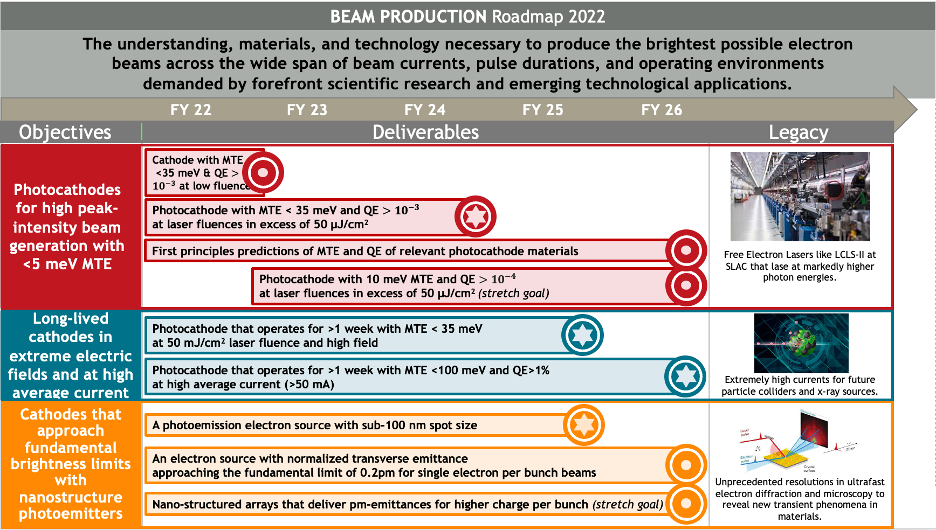Beam Production Optimal Outcome:
To develop the understanding, materials, and technology necessary to produce the brightest possible electron beams across the wide span of beam currents, pulse durations, and operating environments demanded by forefront scientific research and emerging technological applications.
Download the Beam Production Roadmap here .
Objective 1: Develop photocathodes for high peak-intensity beam generation with < 10 meV Mean Transverse Energy (MTE) and good quantum efficiency (QE).
Deliverable: A photocathode with MTE < 35 meV and QE > 10! " at low or moderate laser fluence and at room temperature (Summer 2022).
Deliverable: A photocathode with MTE < 35 meV and QE > 10! " at laser fluences in excess of 50 µJ/cm2 by developing cryo-cooled single-crystal, epitaxial alkali antimonides or other materials (Fall 2024).
Deliverable: First principles predictions of MTE and QE spectral response for relevant photocathode materials (Fall 2026).
Deliverable: A photocathode with MTE < 10 meV and QE > 10! # at laser fluences in excess of 50 µJ/cm2 (Fall 2026 stretch goal).
Objective 2: Design materials for long-lived cathodes in extreme electric field and high average current.
Deliverable: Photocathode that can operate for >1 week with MTE <35 meV at 50 mJ/cm2 laser fluence and high field (>100 MV/m) for high peak current applications such as XFELs (Summer 2025).
Deliverable: Photocathode that can operate for >1 week with MTE <100 meV and QE>1% under high average current (>50 mA) conditions (Summer 2026).
Objective 3: Approach fundamental brightness limits with nanostructured photoemitters.
Deliverable: A photoemission electron source with sub-100 nm spot size (Summer 2025).
Deliverable: An electron source with normalized transverse emittances approaching the fundamental limit of 0.2 pm set by the uncertainty principle for single electron per bunch beams (Fall 2026).
Deliverable: Nano-structured arrays that deliver pm-emittances for higher charge per bunch (Fall 2026, stretch goal).

